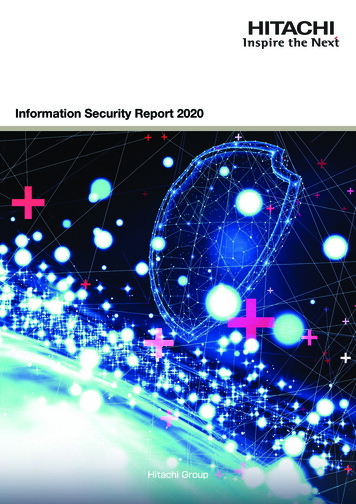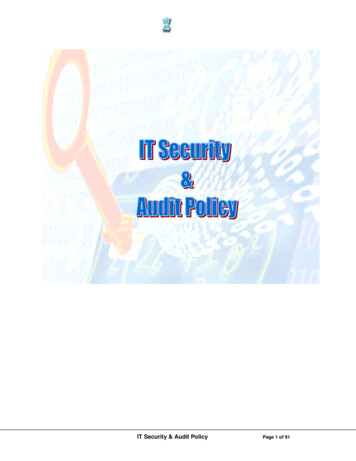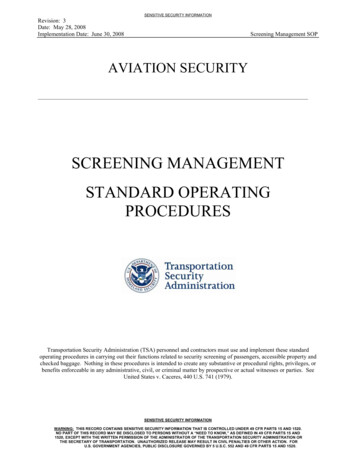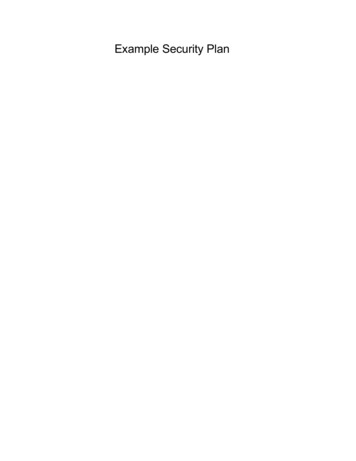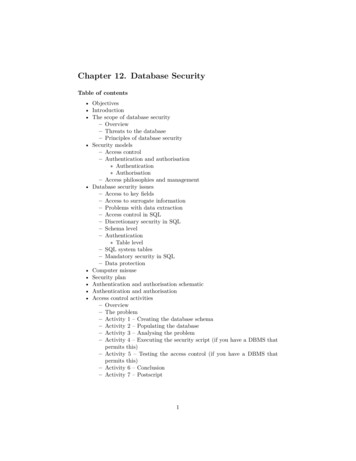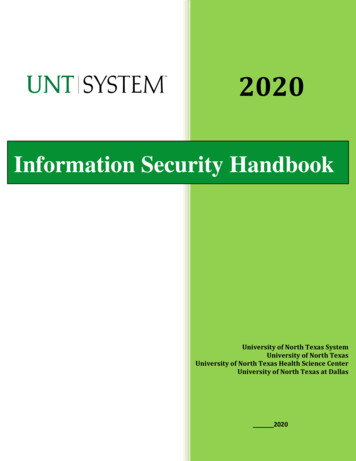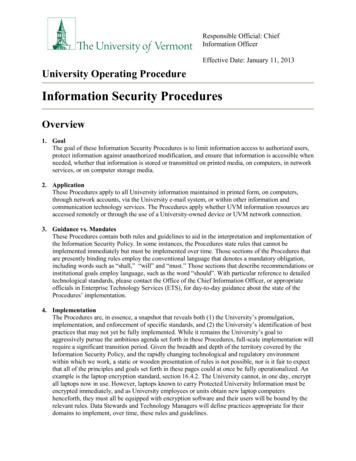
Transcription
Responsible Official: ChiefInformation OfficerEffective Date: January 11, 2013University Operating ProcedureInformation Security ProceduresOverview1. GoalThe goal of these Information Security Procedures is to limit information access to authorized users,protect information against unauthorized modification, and ensure that information is accessible whenneeded, whether that information is stored or transmitted on printed media, on computers, in networkservices, or on computer storage media.2. ApplicationThese Procedures apply to all University information maintained in printed form, on computers,through network accounts, via the University e-mail system, or within other information andcommunication technology services. The Procedures apply whether UVM information resources areaccessed remotely or through the use of a University-owned device or UVM network connection.3. Guidance vs. MandatesThese Procedures contain both rules and guidelines to aid in the interpretation and implementation ofthe Information Security Policy. In some instances, the Procedures state rules that cannot beimplemented immediately but must be implemented over time. Those sections of the Procedures thatare presently binding rules employ the conventional language that denotes a mandatory obligation,including words such as “shall,” “will” and “must.” Those sections that describe recommendations orinstitutional goals employ language, such as the word “should”. With particular reference to detailedtechnological standards, please contact the Office of the Chief Information Officer, or appropriateofficials in Enterprise Technology Services (ETS), for day-to-day guidance about the state of theProcedures’ implementation.4. ImplementationThe Procedures are, in essence, a snapshot that reveals both (1) the University’s promulgation,implementation, and enforcement of specific standards, and (2) the University’s identification of bestpractices that may not yet be fully implemented. While it remains the University’s goal toaggressively pursue the ambitious agenda set forth in these Procedures, full-scale implementation willrequire a significant transition period. Given the breadth and depth of the territory covered by theInformation Security Policy, and the rapidly changing technological and regulatory environmentwithin which we work, a static or wooden presentation of rules is not possible, nor is it fair to expectthat all of the principles and goals set forth in these pages could at once be fully operationalized. Anexample is the laptop encryption standard, section 16.4.2. The University cannot, in one day, encryptall laptops now in use. However, laptops known to carry Protected University Information must beencrypted immediately, and as University employees or units obtain new laptop computershenceforth, they must all be equipped with encryption software and their users will be bound by therelevant rules. Data Stewards and Technology Managers will define practices appropriate for theirdomains to implement, over time, these rules and guidelines.
Information Security ProceduresTABLE OF CONTENTSOVERVIEW . 11. GOAL . 12. APPLICATION . 13. GUIDANCE VS. MANDATES . 14. IMPLEMENTATION . 1SUMMARY OF PERSONAL RESPONSIBILITIES AND LEGAL REQUIREMENTS . 35. ACCOUNTABILITY . 36. PERSONAL RESPONSIBILITIES . 37. EMPLOYEE RESPONSIBILITIES . 38. RESPONSIBILITIES OF DEANS, DIRECTORS, AND DEPARTMENT CHAIRS . 59. RESPONSIBILITIES OF DATA STEWARDS . 610. ADDITIONAL REQUIREMENTS FOR TECHNOLOGY MANAGERS . 611. LEGAL REQUIREMENTS . 7OPERATING PROCEDURES: IMPLEMENTATION DETAILS . 712. ORGANIZATIONAL SECURITY . 713. ASSET CLASSIFICATION AND CONTROL . 1214. PERSONNEL SECURITY . 1315. PHYSICAL AND ENVIRONMENTAL SECURITY . 1316. SECURITY OF EMPLOYEE COMPUTERS AND STORAGE MEDIA . 1317. ACCESS CONTROL . 1718. SYSTEM DEVELOPMENT AND MAINTENANCE . 2219. BUSINESS CONTINUITY MANAGEMENT (DISASTER RECOVERY) (RESERVED) . 22DEFINITIONS . 22CONTACTS/RESPONSIBLE OFFICIAL . 24RELATED DOCUMENTS/POLICIES . 24EFFECTIVE DATE. 25APPENDIX 1: SECURING PROTECTED UNIVERSITY INFORMATION – SUMMARY OFRESPONSIBILITIES . 261. RESPONSIBILITIES OF ALL EMPLOYEES AND CONTRACTORS . 262. RESPONSIBILITIES OF MANAGERS AND SUPERVISORS . 273. RESPONSIBILITIES OF TECHNOLOGY MANAGERS . 274. RESPONSIBILITIES OF DATA STEWARDS . 27APPENDIX 2: PROTECTED UNIVERSITY INFORMATION AGREEMENT FOR VENDORREMOTE OR ON-SITE SUPPORT . 29APPENDIX 3: PROTECTED UNIVERSITY INFORMATION AGREEMENT (NONDISCLOSURE) FOR DATA TRANSFERRED FROM UVM TO AN EXTERNAL SERVICEPROVIDER . 33APPENDIX 4: PROTECTED UNIVERSITY INFORMATION ADDENDUM (NONDISCLOSURE) FOR INFORMATION COVERED BY THE GRAMM-LEACH-BLILEY ACT. 37Page 2 of 40
Information Security ProceduresSummary of Personal Responsibilities and LegalRequirementsIn the normal course of business, the University collects, stores, and reports for internal use certaininformation about individuals that must be kept secure from public disclosure or discussion. Thatinformation is stored in a variety of forms – on paper, on desktop and server computer systems, on CDsand tape backup systems – and is transmitted in a variety of ways such as by U.S. mail, intra-campusmail, FAX, e-mail, or web forms. That information has a very real value, and the University has ethicaland legal responsibilities, as an institution, for ensuring that policies and procedures are in place to protectthose information resources and to secure this information.The collection, storage, and management of that information is generally the province of the individualadministrative or academic offices that use the information. As the steward of the University’s enterprisetechnology resources – central servers and applications systems, networks, telephone systems – EnterpriseTechnology Services has a key responsibility both to secure the information and systems under its directcontrol and to establish policies and procedures that guide and support the offices that actually collect andmaintain the information. Ultimately, the security of the University’s information resources relies uponthe actions of individuals who have access to that information. The following section outlines thosepersonal responsibilities.5. AccountabilityAll information produced, acquired, or maintained by employees of the University of Vermont in thecourse of University business is considered University information. Anyone who collects, stores,processes, transfers, administers, or maintains University information is responsible and heldaccountable for its use.6. Personal Responsibilities6.1. Individuals are responsible for their use or misuse of University information.6.2. Individuals must follow the Privacy Policy and Procedures when Protected Personal Data isaccessed. ies/policies/privacy.pdf)6.3. No institutional data may be stored unencrypted on non-UVM or personally owned computers,including student employees’ computers.6.4. Bypassing network security provisions that protect UVM’s internal network, includingestablishing wireless systems that access that network, is prohibited.6.5. Individuals must safeguard all physical keys such as ID cards or electronic tokens, includingcomputer account (NetID) passwords, that provide access to Protected University Information.6.6. All passwords used for accounts that access enterprise services at the University of Vermont mustadhere to UVM password standards for password strength, including password construction andlifetime.6.7. Individuals must render unusable Protected University Information held on any physicaldocument or computer or computer storage medium that is being discarded.6.8. Activities that may compromise Protected University Information, or evidence that ProtectedUniversity Information has been compromised, must be reported promptly in accordance withthe Data Breach Notification Policy.7. Employee ResponsibilitiesAll members of the UVM community are Users of UVM’s information resources even if they do nothave responsibility for managing information resources. Students, staff, faculty, contractors,consultants, and temporary employees all have access to University information (e.g., file cabinets,Page 3 of 40
Information Security Proceduresdocuments, office desks, account passwords) and are responsible for protecting that informationwherever it is located. Employees (faculty and staff, student employees, and temporary employees)have special responsibilities because of the access they may have to internal University informationresources.7.1. Individuals are responsible for their use or misuse of Protected University Information. Eachindividual who has access to information owned by or entrusted to the University is expected toknow and understand its security requirements and to take measures to secure the informationthat are consistent with the requirements defined by its Data Steward, wherever it is located, bylocking doors and filing cabinets, protecting account passwords, protecting computerworkstations, or encrypting Protected University Information that may be transmitted.Computer workstations must be configured to require username/password on startup. Mobiledevices that are used to access any UVM information service other than http://www.uvm.edumust be configured to require a personal identification number (PIN) to unlock and must lockafter no more than ten minutes of inactivity.7.2. Individuals must take appropriate measures to safeguard Protected University Informationwherever it is located, such as on physical documents (forms, reports, microfilm/fiche), in filingcabinets, stored on computer media (disks, tapes, CDs/DVDs, USB “thumb” drives),transferred over fax, voice or data networks, exchanged in conversations, etc.7.3. Individuals must safeguard any physical key, ID card, computer/network account or electronictoken that provides access to confidential information. This includes safeguarding computeraccount (NetID) passwords. Users are personally accountable for all network and systemsaccess under their NetID and must keep their password absolutely secret. Passwords must neverbe shared with anyone, not even family members, friends, or technology support staff.7.4. The University provides network file storage for faculty and staff use associated with UVM work,and those systems are backed up automatically. Faculty and staff should use domain-joined filestorage for their workstations whenever possible to ensure business continuity in the event ofequipment failure, loss, or theft. Employees are responsible for backing up UVM informationthat has not been stored on automatically-backed-up enterprise network storage.7.5. Employees must keep work areas clear of confidential materials and configure computerworkstations to blank and lockout screens after no more than ten minutes of inactivity,requiring a password to unlock upon return. Employees should consciously activatescreensaver/lockout when leaving visual proximity of their workstations.7.6. To help prevent identity theft, the University requires that its employees take extra precautionswhen collecting, using, or storing personally identifiable information such as: Social SecurityNumber (SSN), date of birth, place of birth, mother’s maiden name, credit card numbers, bankaccount numbers, or motor vehicle operator’s license numbers. These data must be collected orused only for justifiable business needs and only when there is no reasonable alternative. Inparticular, SSN’s should not be used as an internal identifier on forms, reports, screens, etc.Under no circumstances should credit card numbers, SSN, bank account numbers, etc. beexchanged via unencrypted e-mail, since e-mail may be transmitted or stored insecurely.Managers must ensure that their employees understand the need to safeguard this informationand that adequate procedures are in place to minimize the risk of disclosure.7.7. Unencrypted disks, CDs/DVDs, electronic mail (e-mail), electronic chat sessions, instantmessages, and unsecured file transfer protocol (FTP) are insecure mechanisms and may not beused to exchange Protected University Information. Any transfer of such information,authorized by its Data Steward, must employ data encryption methods approved by theInformation Security Office. Communication involving sensitive, or protected information mustuse UVM-provided services rather than public systems such as AIM/Yahoo/Google/MS.7.8. Physical documents, CDs, and DVDs containing Protected University Information secured inlocked cabinets or rooms should not be removed from campus. Protected UniversityInformation on computer systems or storage devices may be removed from campus only ifthose devices are encrypted.Page 4 of 40
Information Security Procedures7.9. Any University-owned laptop computer used to access UVM non-public data or file servicesmust have its storage system encrypted using a University-approved encryption system, withUVM retaining the encryption key.7.10. Any personally owned computer system, laptop or desktop, used to access UVM file services ornon-public data for anyone other than the individual user must have its storage systemencrypted with a system of the owner’s choice.7.11. USB thumb drives, “Secure Disk” or “Compact Flash” drives, CDs/DVDs, PDAs,SmartPhones, etc., that are used to store or transport Protected University Information must beencrypted with University-approved encryption systems.7.12. Any computer, computer storage system, or removable storage medium that has been used tohold Protected University Information must be physically destroyed or electronically“scrubbed” using software approved by the Information Security Office before being discardedor transferred to any individual or entity not authorized to view the information. The meredeletion of Protected University Information is not sufficient to render it unreadable. Any nonerasable medium (such as CDs or DVDs) that has been used to hold Protected UniversityInformation must be physically destroyed before being discarded. The ISO can provideassistance in scrubbing or destroying media.7.13. Individuals must not in any way divulge, copy, release, sell, loan, review, alter, or destroy anyinformation except as properly authorized within the scope of their professional responsibilitiesand in accordance with the Records Management and Retention Policy.7.14. Individuals who are not aware of the security requirements for information to which he or shehas access must treat that information as maximally protected until requirements can beascertained from the appropriate supervisor or Data Steward.7.15. The sharing of a single network or systems account among a group of individuals is stronglydiscouraged and should only occur where no reasonable technical alternative is available.Generally, account responsibility should be vested in a single individual.7.16. Activities that may compromise confidential information must be reported in accordance withthe Data Breach Notification Policy.8. Responsibilities of Deans, Directors, and Department ChairsDeans, directors, and department chairs are expected to:8.1. Understand the security-related requirements for information collections used within theirrespective departments by working with the appropriate Data Stewards and their designees.8.2. Develop security practices that are consistent with these Information Security Procedures and thePrivacy Policy and Procedures that support the University’s objectives for confidentiality,integrity, and availability of information as defined by the Data Stewards, and ensure that thoseprocedures are followed.8.3. Ensure that their staff members have just the minimum access authorizations to information toperform their jobs and ensure that those authorizations are removed (keys returned, securitycodes changed, computer accounts de-authorized) upon separation from the University or achange in job responsibilities/position. Managers are responsible for administering andretaining written and signed confidentiality agreements for staff from whom those agreementsare required by Data Stewards.8.4. Communicate effectively any restrictions on access or modifications to information to those whouse, administer, process, store, or transfer the information in any form.8.5. Ensure that each staff member understands their information-security-related responsibilities andacknowledges that they intend to comply with those requirements by having staff review the“User responsibilities” in sections 6 and 7.8.6. Ensure that information and proprietary software are removed from University computers beforedisposal, whether the equipment is relocated on campus or removed from campus (see section16.3 of the Operating Procedures below). ETS offers technical advice and tools to assist inremoving information (merely deleting is not sufficient!). Physical Plant will pick up computersand ensure environmentally safe disposal.Page 5 of 40
Information Security Procedures8.7. Report in accordance with the Data Breach Notification Policy any evidence that information hasbeen compromised or any suspicious activity that could potentially expose, corrupt, or destroyinformation.9. Responsibilities of Data StewardsUniversity-held information must be protected against unauthorized exposure, tampering, loss, anddestruction. That information is generally collected, stored, and processed by individual offices thatuse the paper or computer files in the normal course of business. Each collection is associated with anindividual known as a Data Steward who must:9.1. Define the collection’s requirements for security, including confidentiality, integrity, andavailability, consistent with these Procedures, the Privacy Policy and Procedures, RecordsManagement and Retention Policy, and other University policies, contractual agreements, laws,and regulations (see section 13, Asset Classification And Control);9.2. Convey the collection’s security requirements in writing to the managers of departments that willhave access to the collection;9.3. Work with department heads and chairs to determine the users, groups, roles, or job function thatare authorized to access the information in the collection and in what manner (e.g., who canview the information, who can update the information);9.4. Ensure that contracts with third parties (consultants, service providers) include provisions formaintaining security of information to which they may have access (see model agreements inthe Appendices 2, 3 and 4).Data Stewards may designate one or more individuals to perform the above duties. However, theSteward retains ultimate responsibility for their actions. Section 12.2.3 lists the Data Stewards formajor collections of University information.10. Additional Requirements for Technology ManagersTechnology Managers support computing and networking environments where Universityinformation is collected, stored, transmitted, or processed. Those environments include: Computer servers such as Unix/Linux and Windows servers Database environments relying upon database systems such as Oracle, SQL Server, MySQL,Access, Approach, and FileMaker Applications environments, both locally and externally hosted, such as PeopleSoft, Banner,Sungard Advance, FAMIS, Kronos, Diebold, Luminis, Digital Measures, PeopleAdmin, SungardEvent Management, and Sungard SmartCall Network system components such as routers, switches, and firewalls Physical media storage such as tape libraries, file storage systems, and CD/DVD libraries.Technology managers face more extensive requirements to ensure the security of the technologysystems under their management that store and process information, in accord with the DataSteward’s definitions, by implementing:10.1. Physical security protection for the equipment for which they are responsible;10.2. Computer security measures for protecting information systems against unauthorized ormalicious access or threats posed by computer hackers, including maintaining system securitypatches and antivirus systems;10.3. Procedures for administering system and network accounts and access authorizations thatsatisfy security requirements. For example, for Enterprise information systems, all systemsmaintenance (device firmware, storage systems, server OS, network devices, network services),and all configuration changes to network topology, firewalls, load balancers, and storagesubsystems, shall be approved in advance by the Director of Systems Architecture andAdministration or the Director of Telecommunication and Network Services or their designees.Records of the planned changes and the approval of the designated authority shall bemaintained for audit purposes; andPage 6 of 40
Information Security Procedures10.4. Activity logs for system and network utilization and by monitoring those logs for unusualevents that might signal intrusion and access or modification of Protected UniversityInformation.11. Legal RequirementsThe University must be mindful of a number of federal and state laws and regulations governing thesecurity of information. The Privacy Policy identifies those laws addressing Protected Personal Data.Those laws as well as additional laws and regulations addressing information security apply acrossthe University and are particularly relevant for certain individual departments and services include thefollowing:11.1. FERPA (Federal Educational Rights Privacy Act) governs the release of information aboutstudents.11.2. Vermont Act 162 requires that individuals be informed if certain types of personal or financialinformation are exposed accidentally or through a breach in information security.11.3. HIPAA (Health Information Portability and Accountability Act) establishes privacy standardsfor certain health information records. The HITECH (Health Information Technology forEconomic and Clinical Health) Act extends the provisions of HIPAA to include new breachnotification requirements, establishes requirements for auditing disclosure of information, andincreases penalties for violations.11.4. PCI-DSS (Payment Card Industry – Data Security Standards) is a set of standards required bythe payment card industry to help protect credit/debit card information. All “merchants” whoprocess credit cards are required to meet procedural and data security standards.11.5. GLBA (Gramm-Leach-Bliley Act) requires that all personally identifiable financial informationfrom students, parents, and employees be safeguarded against foreseeable risks of disclosure,intrusion, and systems failure.11.6. CFAA (Computer Fraud and Abuse Act) makes illegal the use of inter-state or internationalcommunications for unauthorized access to “protected computers.”11.7. ECPA (Electronic Communications Privacy Act) prohibits unauthorized access to or disclosureof electronically-stored information, including access by employees to information not withinthe scope of their duties.11.8. TEACH (Technology, Education, and Copyright Harmonization) Act allows colleges anduniversities to use multimedia content for instruction but requires security provisions to ensurethat digitally-transmitted content is available only to students who are properly enrolled in thecorresponding course.Operating Procedures: Implementation DetailsThe following sections provide implementation details associated with the Information Security Policy.The University of Vermont requires all members of the UVM community to manage the informationunder their control so as to protect that information and ensure its appropriate use, and protecting theinformation resources of the University. This requirement is embodied in the Information Security Policy,to which these procedures are attached and into which they are incorporated by reference. Theseprocedures may be amended from time to time in response to experience gained or changingcircumstances.12. Organizational SecurityAll members of the University community share in the responsibility for protecting informationresources for which they have access or custodianship. Most of the responsibilities set forth in thissection are assigned to four groups of people: Data Stewards, Managers (of Users), Users, andTechnology Managers. In general, an individual will have responsibilities in more than one area, forexample as both Data Steward and User of information resources and possibly as Manager of aPage 7 of 40
Information Security Proceduresdepartment. This section also articulates specific responsibilities for the University’s InformationSecurity Office, Privacy Office, Audit and Compliance Office, and General Counsel's Office.12.1. Management CommitmentUVM’s Senior Administration commits to securing its information resources by approving thisPolicy and its Procedures and by charging members of the UVM community to ensure itsimplementation. It has also instituted senior positions of Privacy Officer, Chief InternalAuditor, and Information Security Officer to verify compliance and update the Policy as legalrequirements and best practices evolve.12.2. Information Security Management12.2.1. Information Security ProgramTo promote the security mandate of the University, the University of Vermont:12.2.1.1. Supports risk management and compliance programs pertaining toinformation security in compliance with regulations and industryrequirements such as FERPA, Vermont Act 162, HIPAA, Gramm-LeachBliley, and PCI DSS.12.2.1.2. Approves and adopts broad information security program principles andseeks to implement best practices in information security.12.2.1.3. Strives to protect the interests of all stakeholders dependent on informationsecurity.12.2.1.4. Reviews information security policies regarding strategic partners and otherthird parties.12.2.1.5. Strives to ensure business continuity.12.2.1.6. Conducts regular internal and external audits of the information securityprogram.12.2.1.7. Provides information security metrics to be reported to the Board.12.2.2. Information security coordinationTo promote the security mandate of the University, management shall:12.2.2.1. Establish information security management policies and controls and monitorcompliance.12.2.2.2. Assign information security roles and responsibilities, set minimum requiredskills for access, and enforce role-based information access privileges.12.2.2.3. Assess information risks, establish risk thresholds, and actively manage riskmitigation.12.2.2.4. Require implementation of information security requirements for strategicpartners and other third parties.12.2.2.5. Identify and classify information assets.12.2.2.6. Implement and test business continuity and disaster recovery plans.12.2.2.7. Approve information systems architecture during acquisition, development,operations, and maintenance.12.2.2.8. Protect the phys
Jan 11, 2013 · The goal of these Information Security Procedures is to limit information acc ess to authorized users, protect information against unauthorized modification, and ensure that information is accessible when needed, whether that information is stored or transmitted on printed media, on compute
